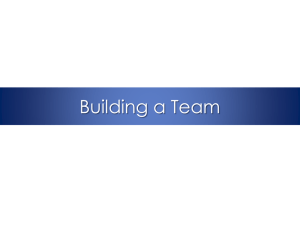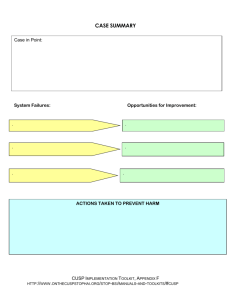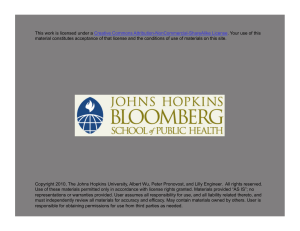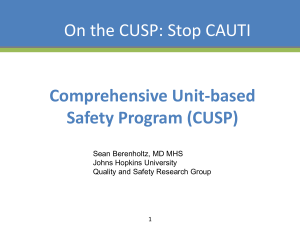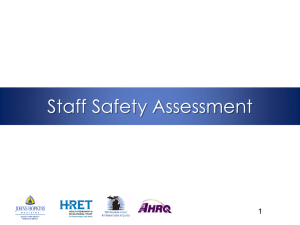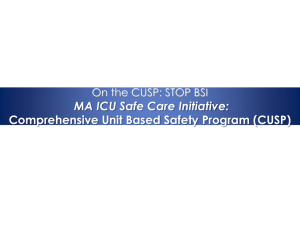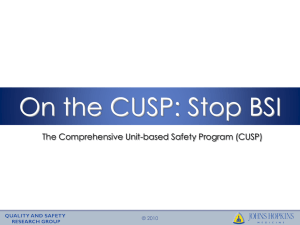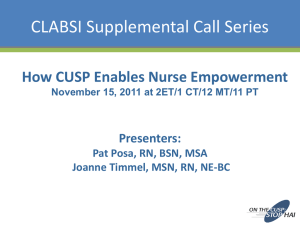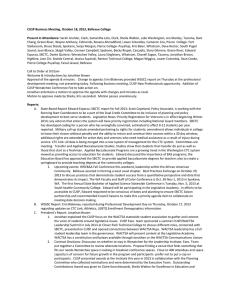CUSP - Johns Hopkins Medicine
advertisement
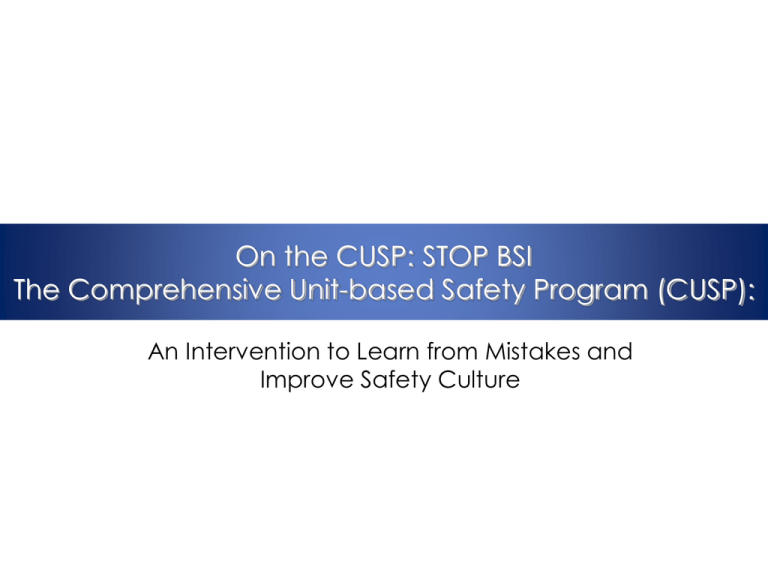
On the CUSP: STOP BSI The Comprehensive Unit-based Safety Program (CUSP): An Intervention to Learn from Mistakes and Improve Safety Culture Immersion Call Overview Week 1: Project overview Week 2: Science of Improving Patient Safety Week 3: Eliminating CLABSI Week 4: The Comprehensive Unit-Based Safety Program (CUSP) Week 5: Building a Team Week 6: Physician Engagement © 2009 The CUSP/ CLABSI Intervention CUSP CLABSI 1. Educate staff on science of safety 1. Remove Unnecessary Lines 2. Identify defects 2. Wash Hands Prior to Procedure 3. Assign executive to adopt unit 3. Use Maximal Barrier Precautions 4. Learn from one defect per quarter 4. Clean Skin with Chlorhexidine 5. Implement teamwork tools 5. Avoid Femoral Lines www.safercare.net © 2009 Learning Objectives • To explain the philosophy and approach of CUSP • To describe the steps in CUSP • To introduce available teamwork tools on safercare.net © 2009 What is CUSP? • Comprehensive Unit-based Safety Program • An Intervention to Learn from Mistakes and Improve Safety Culture © 2009 On the CUSP: Stop BSI Intervention Comprehensive Unitbased Safety Program (CUSP) -Improve or reinforce good crossdisciplinary communication and teamwork -Enhance coordination of care -Address overall patient safety -Work towards healthy unit culture BSI-Reduction Protocol -Best-evidence supplies, organization of supplies -Ensuring all patients receive the best practices --Checklist to ensure consistent application of evidence Safety Score Card Keystone ICU Safety Dashboard 2004 2006 How often did we harm (BSI) (median) 2.8/1000 0 How often do we do what we should 66% 95% How often did we learn from mistakes* 100s 100s Have we created a safe culture What areas need improvement (%) Safety climate* Teamwork climate* 84% 82% 43% 42% * CUSP is intervention to improve these © 2009 Pre CUSP Work • Create a CUSP/CLABSI team – Nurse, physician administrator, others – Assign a team leader • Measure culture in the unit • Work with hospital quality leader or hospital management to have a senior executive assigned to CUSP/CLABSI team © 2009 Steps of CUSP 1. Educate staff on Science of Safety 2. Identify defects 3. Assign executive to adopt unit 4. Learn from one defect per quarter 5. Implement teamwork tools Pronovost J, Patient Safety, 2005 © 2009 Step 1: Science of Safety • Understand system determines performance • Use strategies to improve system performance – Standardize – Create independent checks for key process – Learn from mistakes • Apply strategies to both technical work and team work • Recognize teams make wise decisions with diverse and independent input • http://www.safercare.net/OTCSBSI/Staff_Training/Entries/2009 /9/6_1._The_Science_of_Improving_Patient_Safety.html © 2009 Step 2: Identify Defects • Review error reports, liability claims, sentinel events or M and M conference • Ask staff how will the next patient be harmed © 2009 Prioritize Defects • List all defects • Discuss with staff what are the three greatest risks © 2009 Step 3: Executive Partnership • Executive should become a member of ICU team • Executive should meet monthly with ICU team • Executive should review defects, ensure ICU team has resources to reduce risks, and hold team accountable for improving risks and central line associated blood steam infection © 2009 Step 4: Learning from Mistakes • What happened? • Why did it happen (system lenses) ? • What could you do to reduce risk ? • How do you know risk was reduced ? – Create policy / process / procedure – Ensure staff know policy – Evaluate if policy is used correctly Pronovost 2005 JCJQI © 2009 Step 4 cont’d: Identify Most Important Contributing Factors • Rate each contributing factor – importance of the problem and contributing factors in causing the accident – importance of the problem and contributing factors in future accidents © 2009 Step 4 cont’d: Identify Most Effective Interventions • Rate Each Intervention – How well the intervention solves the problem or mitigates the contributing factors for the accident – Rates the team belief that the intervention will be implemented and executed as intended © 2009 Step 4 cont’d: Evaluate Whether Risks were Reduced • Did you create a policy or procedure • Do staff know about the policy • Are staff using it as intended • Do staff believe risks have been reduced © 2009 Step 5: Teamwork Tools • Call list • Daily goals • AM briefing • Shadowing • Culture check up Pronovost JCC, JCJQI © 2009 Step 5 cont’d: Call List • Ensure your ICU has a process to identify what physician to page or call for each patient • Make sure call list is easily accessible and updated © 2009 Step 5 cont’d: AM Briefing • Have a morning meeting with charge nurse and unit attending(s) about the unit-level plan for the day • Discuss work for the day – What happened during the evening – Who is being admitted and discharged today – What are potential risks during the day, how can we reduce these risks © 2009 Step 5 cont’d: Shadowing • Follow another type of clinician doing his or her job for between 2 to 4 hours • Have the shadower discuss with staff what she will do differently now that she has walked in another person’s shoes © 2009 CUSP is a Continuous Effort • Add Science of Safety education to orientation • Learn from one defect per quarter, share or post lessons • Implement teamwork tools that best meet the unit’s needs • Details are in the CUSP manual © 2009 Action Items--CUSP • Look over the CUSP manual with team members • Brainstorm potential hazards with team • Assess team composition with respect to CUSP elements • REVIEW PRE-IMPLEMENTATION CHECKLIST—where are you? © 2009 References • Pronovost P, Weast B, Rosenstein B, et al. Implementing and validating a comprehensive unit-based safety program. J Pat Safety. 2005; 1(1):33-40. • Pronovost P, Berenholtz S, Dorman T, Lipsett PA, Simmonds T, Haraden C. Improving communication in the ICU using daily goals. J Crit Care. 2003; 18(2):71-75. • Pronovost PJ, Weast B, Bishop K, et al. Senior executive adopt-a-work unit: A model for safety improvement. Jt Comm J Qual Saf. 2004; 30(2):59-68. • Thompson DA, Holzmueller CG, Cafeo CL, Sexton JB, Pronovost PJ. A morning briefing: Setting the stage for a clinically and operationally good day. Jt Comm J Qual and Saf. 2005; 31(8):476-479. © 2009

